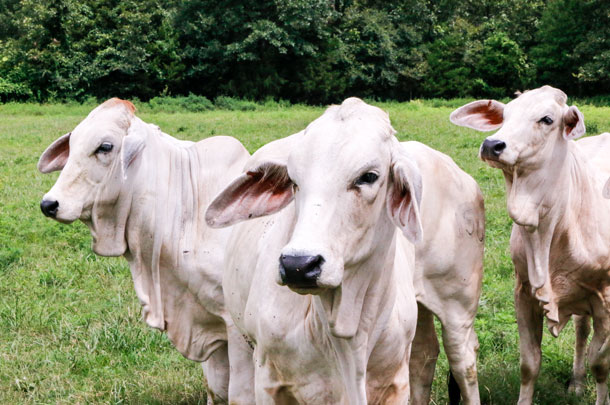With 500 acres of dallisgrass, bermudagrass, fescue and johnsongrass, David and Lisa Long will take one to four cuttings a year and put up 650 to 700 round bales in Waldron, Arkansas. If he had a market to sell the hay to, it still wouldn’t provide enough to make a living, but additional land isn’t as available as it once was. Long knew something at Peaceful Valley Farms had to change.
Arkansas once boasted of being the poultry capital of the U.S. Over the past few decades, however, the Arkansas poultry industry closed a lot of smaller barns and conceded “top poultry producer” status to Georgia. “But,” says David Long, “even with the poultry industry dwindling, it’s getting harder to find land.” So he looked at options to maximize what land he did have, and that’s when he invested in a registered Brahman herd.
“Commercial cattle weren’t bringing enough back then, and I had to figure out how to get more value from the land I had. I decided to have fewer numbers but market a higher-dollar animal,” Long says. “It was a way to maximize what land I did have.”
With fewer than 20 registered Brahman breeders in Arkansas, Long found a ready market for Brahman heifers – a waiting list, in fact, of buyers. Marketing over the internet, today Long has customers from half a dozen states away.
Long’s current herd of 130 cows is well suited to the Arkansas heat. “On a hot day,” Long says, “my Brahman cows will be out in the sun grazing or laying down, not holed up in the shade or standing in water like other breeds do.” He also notes their good temperament and hardiness. “I never have to pull a calf, and with their skin pigmentation, I don’t have trouble with pink eye. They’re just a more hardy cow,” he says. And while Brahmans don’t give the quantity of milk or have big udders like some breeds, he says the milk is richer.
Long offers this information as proof of their hardiness: “Brahman cows won’t touch bermudagrass until it’s frosted if there’s anything else to eat. They’re more like a goat in that regard – they’ll forage on bitterbrush. They’re good at foraging.”

In mid-September, Long no-tills ryegrass into pastures, which comes up in about a month. The cows can then graze that until the first of the year. Long feeds hay until about March, when the fall calving herd weans 600-pound calves, which will have to be dehorned.
Long uses natural bull service in his herd, with bloodlines coming from the breeding herd of J.D. Hudgins Inc. in Hungerford, Texas (southwest of Houston). J.D. Hudgins Inc. has been in the business of raising and showing registered cattle since the early 1900s with breeding beef-type Brahmans. “Manso,” the heavy-muscled, steel-colored bull Walter Hudgins bought in 1933 as a 7-year-old (in trade for four young bulls), has earned the moniker “father of today’s Brahmans,” and at one time the breed association estimated that over 75 percent of all registered Brahman cattle today carry Manso breeding.
Long markets mainly through previous buyers and a number of industry contacts, but also uses the internet – through Facebook and Craigslist. He says, “I sell a lot of my bulls to local people who breed them with Hereford cows. Everybody’s after what they call the ‘tiger stripe.’”
F1 tiger stripe females are hailed as superior cows for the South and Southeast. Their advantage is being well suited to hot and humid climates. Because of heat tolerance, they will graze during the heat of the day when English breeds are standing in water or resting in the shade. F1 females are claimed to outlive and be productive three to five years longer than a straight English breed female because of the Brahman influence. Even though tiger stripe steer calves with “a little more navel and ear on them” may take a slight hit at the auction barn, the females are in high demand for replacement heifers, which makes up for the loss.
Because Long maximized his land through a higher value animal, even with his current herd, he has been able to market the extra hay his current acres provide. Business is not always a matter of working harder; sometimes you just have to work smarter. ![]()
See more of Peaceful Valley Farms in this slideshow.
PHOTO 1: With 500 acres of dallisgrass, bermudagrass, fescue and Johnsongrass, David Long will take one to four cuttings a year and put up 650 to 700 round bales in Waldron, Arkansas, for his registered Brahman herd.
PHOTO 2: With land values climbing and availability declining, Long decided to maximize his output by converting a commercial herd to a registered herd, which resulted in fewer animals but a higher-dollar animal. Photos by Lynn Jaynes.

-
Lynn Jaynes
- Editor
- Progressive Cattleman
- Email Lynn Jaynes








